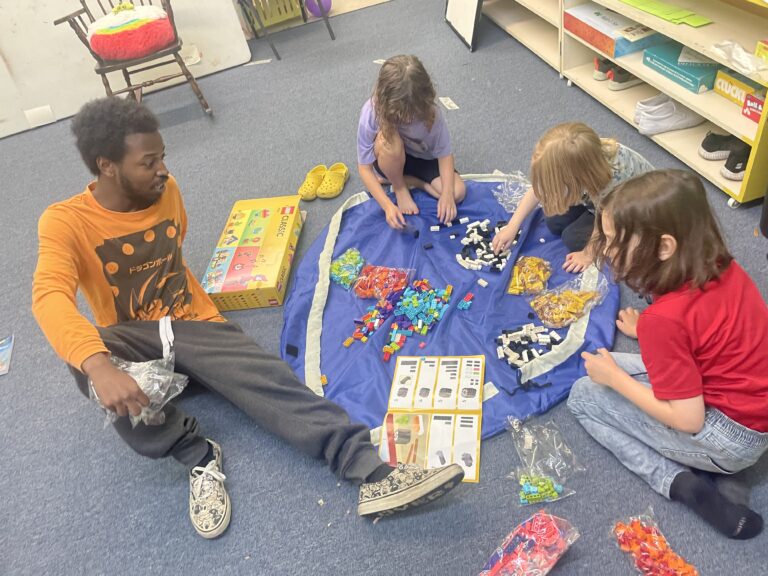The Learning Curve, Pt. 3
This blog is the last in my little series of things I’ve learned as an educator about kids and how we adults can best support them as they grow. Part One of this series was a general commentary on kids’ flexibility and resilience, with a little bit about setting boundaries. Part Two talked about kids, their challenging behaviors, and gave some advice about the first steps for dealing with them. In this installment of “The Learning Curve,” I’m going to dive into some specifics of how to deal with some of the challenging behaviors that kids — both big and little — exhibit. (<<in imitation of a certain Italian plumber>>:) Here we gooooooo!
Challenging Behavior #1: Tattling
If you’re like me, you have kids in your life that want to tell you every single thing that another kid does wrong. And we want our kids to stand up for justice… right? …But we don’t want to hear “MOOOOOM, JIMMY’S MAKING A FACE AT ME AGAIN” every ten minutes, either.
Chances are, the tattler is bringing their trusted adult this troubling information because they don’t know how to handle the situation with Jimmy themselves. So, trusted adult can help in two ways: 1) help the tattler (let’s call them “Mia”) learn to set boundaries with “I Statements,” and 2) establish logical consequences for Jimmy when Mia tells him she’d like him to stop but he doesn’t.
For example: Mia uses this “I-Statement”: “Jimmy, I feel upset when you make weird faces at me because I feel like you’re making fun of me. Could you please stop doing that?” In response, Jimmy may agree to stop, and then actually stop doing it… orrrrr he might agree in the moment, but continue doing it later. If the latter is the case, establish a logical consequence: “Jimmy, your sister has kindly asked you to stop making faces at her, but you have continued to do it. If you make faces at her again, you’ll have to go play on your own in a separate room for awhile.” The logic of this consequence is that Jimmy didn’t respect Mia’s boundary, so he needs to take a break from playing with her for a bit.
It will take a while for Jimmy and Mia to get the hang of using “I-Statements” and respecting boundaries, but don’t give up! Stay consistent, and the tattling will subside as each kiddo learns to speak for themselves to their siblings, and therefore doesn’t always have to bring Mom or Dad into it.
Challenging Behavior #2: Tantrums
People of ALL ages throw tantrums. It’s not just toddlers, and it’s definitely not just teenagers. We all do it from time to time; ours as adults simply look and sound a little different and are a bit more subdued.

When your child – toddler, teen, or grown – throws a tantrum with you, the first step is to just breathe. Recognize that they are having a hard time, and it’s making you have a hard time. Once you recognize this, you can show yourself some compassion, and then show them some compassion.
After that first steadying breath, don’t be afraid to talk to yourself. I do this all the time. When my kiddo is going off the rails with a meltdown – and I happen to remember my own advice, which isn’t always, okay – I breathe and I say to myself, “It’s okay, Sarah. It’s gonna be okay. You are patient; you are kind; you are gentle; you are loving.”
Once I’ve convinced myself not to blow my own lid, I offer compassion to my kiddo. I tell her, “I’m here to talk when you’re ready,” and maybe offer her a comforting stuffie, or just my hand, to hold. She might not want to take it. I tell her that I’ll be available to her when she’s calmed down enough to talk to me, and then I step away. When she’s more chill, she approaches me and we talk about our feelings and hug it out. 🙂
This approach has helped me TREMENDOUSLY both at home and in the classroom; I hope it helps you too.
Challenging Behavior #3: Disrespect

Call it out when you see it, guys. Indirectly if necessary; it depends on the situation and what kind of mood your kid is in. But never just let it sit there. This is where our I-Statements come in to save the day again.
If your kiddo is rude to you for seemingly no reason, step back and check in. What’s going on with them? Is something else bothering them that they need to tell you? Did you do something that upset them (it totally happens sometimes without us realizing it)? Offer compassion first; then use your I-Statement to let them know it’s not okay, and that you need respect and kindness from them.
If they are rude to someone else in front of you, it’s a trickier situation. You want to first offer them the chance to realize their mistake and make amends with the person. I might give them a questioning look, for example, and see if they acknowledge what they just said or did. If they don’t immediately make amends to apologize, then ask them a guiding question or three: “Stephanie, how do you feel about what you just said to Kim? …Why did you say it? …What is the best way to fix this situation…?”
Nine times out of ten, Stephanie will recognize that she just did something mean, and apologize to Kim…. unless there is some “bad blood” between the two – a history of wrongdoings. Then, you have to sit down and dig deep into the past hurts, to find where it all began, what common ground the two have, and how the relationship can heal.
Some Final Thoughts
This blog has gone on a long time. I really hope it contained some information that you’ll find useful. These are things I’ve learned from teaching, professional developments, personal therapy, child psychology classes, working with a child therapist, my Master’s program, and reading what feels like a metric ton of blogs and books. They’re not my ideas, y’all, and they go so much deeper than the surface I’ve scratched here. If I can recommend only one resource for you to start learning more about problem-solving with kids, I would tell you to check out Dr. Ross Greene’s work. The short version of all this?
How to deal with challenging kid behaviors: First, find the feelings and needs b







